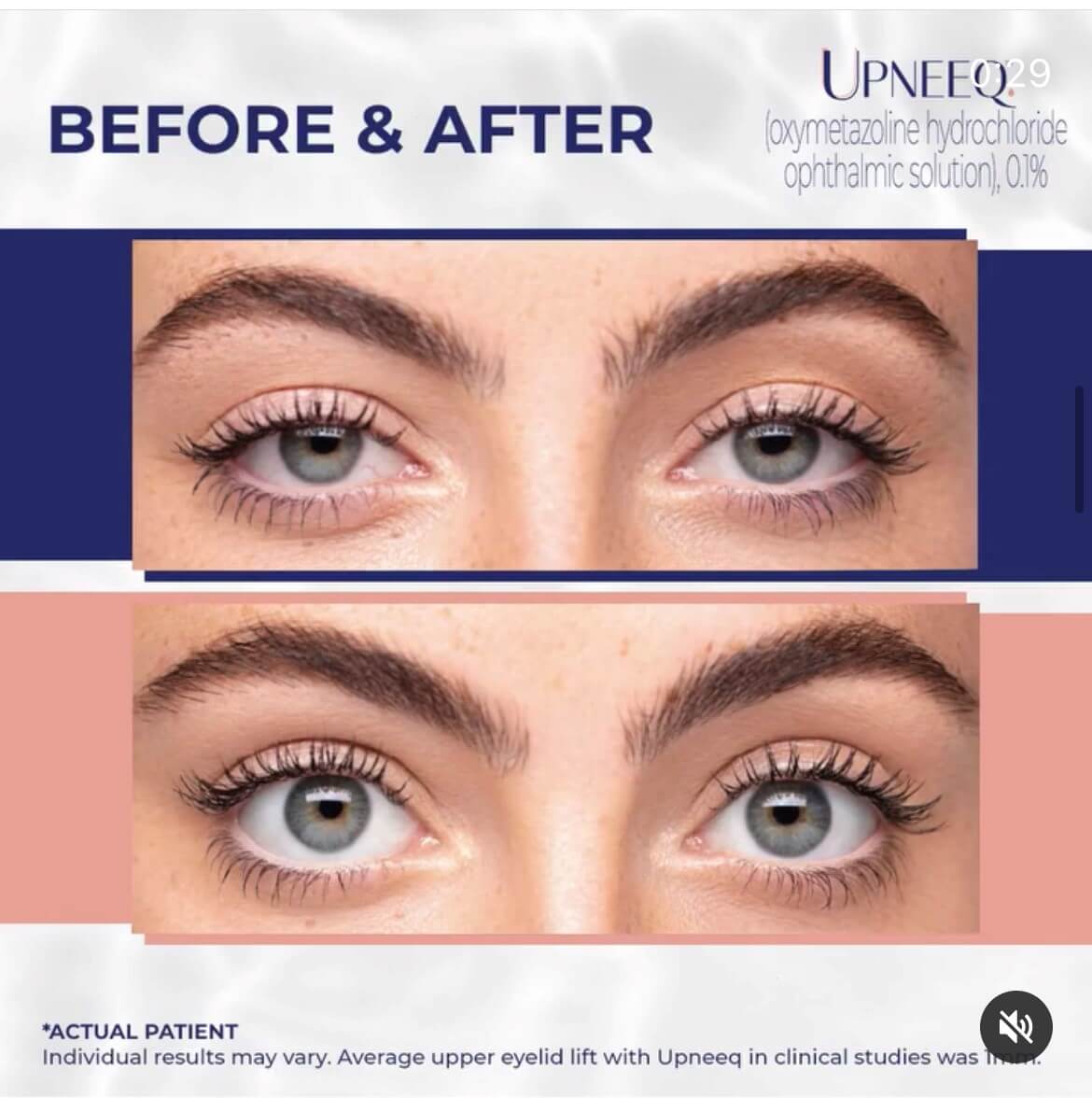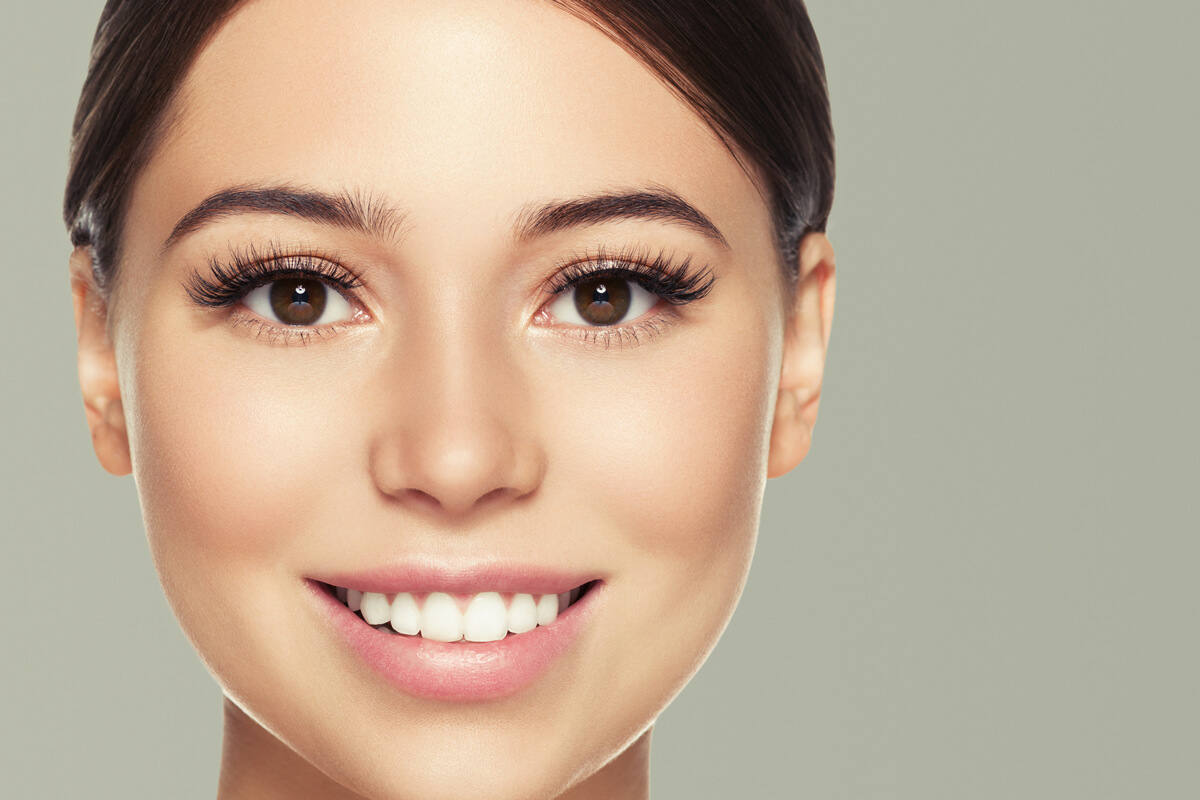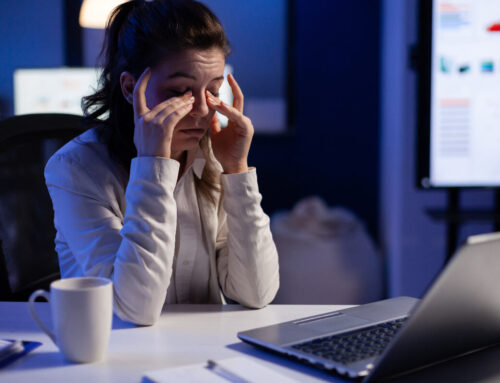Do you have drooping eyes? In the past, the only treatment for any drooping eyelid was surgery. However, surgery has a certain amount of risks, and many people find it challenging to correct their droopy eyelids. Now, people with droopy eyelids can use Upneeq as a temporary alternative. One drop of Upneeq can lift the eyelid by 1-2 mm and the effect will last 6-8 hours.
What is Upneeq?
Upneeq is an FDA-approved prescription eye drop used to treat acquired droopy eyelids. Upneeq is used to elevate your upper lid by 1-2 millimeters.
What is acquired ptosis?
Acquired ptosis, also known as acquired blepharoptosis, is a disorder that appears when the upper eyelids start to droop or sag. This drooping occurs when the muscles or nerves that hold the eyelids deteriorate. Aging is the leading factor that causes the eyes’ muscles to weaken. However, there are other causes of acquired ptosis, such as neurological or nerve disorders, tumors on the eyelids, multiple sclerosis (MS), and diabetes. Droopy or sagging eyelids may impact your appearance. It may make you look exhausted or older. Additionally, sagging eyelids can hinder your superior view of vision and make it more difficult to see. Acquired ptosis should be treated immediately after you are diagnosed.
How does Upneeq help with ptosis?
The active ingredient oxymetazoline hydrochloride in Upneeq will cause the contraction of the Muller’s muscle, which is one of the upper eyelid muscles, thus giving the user the appearance of having wider and more open eyes for up to six hours.

How to use Upneeq?
Upneeq comes in a single-use vial. Once you twist the vial opens, simply put one drop into each eye. You can take Upneeq if you wear contact lenses, as long as you wait 15 minutes after administering the eye drops before inserting your lenses.
Is it okay to combine Upneeq with other eye drops?
Most likely, you can use Upneeq along with other eye drops. Wait 15 minutes before putting in any other eye drops after taking Upneeq (or inserting contact lenses). Discuss all of your prescription, over-the-counter, and eye drops medications during your appointment to determine whether they are safe to take with Upneeq.
Can Upneeq be used to treat other eye conditions such as dry eye?
No, Upneeq must only be taken as prescribed by a professional to address drooping eyelids. However, Upneeq does contain some lubricants for the eyes. Many patients report their eyes feel “less dry” while using Upneeq. For more information, make an appointment with our optometrist at Eye Candy Vision and Beauty Clinic.
What is the price of Upneeq?
A 45-day supply costs $180.
How should I use for Upneeq?
You can apply Upneeq to the affected eye(s) in two simple steps.
Step 1: Open the foil wrapper and take out the single-use vial.
Step 2: Apply one drop of Upneeq daily in each affected eye.
Note:
- Do not allow the vial’s tip to contact your eye or surface.
- After applying a drop, vials should not be reused after being opened and should be discarded.
- Wait 15 minutes to put in your contact lenses on after instilling Upneeq eye drop into the eyes.
- If you use more than one medication to your eye, make sure that at least 15 minutes in between the application of each medication.
How fast does Upneeq work?
Most people will experience the effect within 15-30 minutes of using Upneeq.
Can Upneeq treat any droopy eyelid?
The FDA has given Upneeq approval to treat specific types of acquired ptosis. Therefore, droopy eyelids present from birth cannot be treated with Upneeq. Also, Upneeq can not help with droopy eyelids caused by a tumor on the eyelid or fat sagging around. Our professionals at Eye Candy Vision and Beauty clinic, Arcadia, will conduct an evaluation whether Upneeq is the best option for you.
Is Upneeq available over the counter?
Upneeq is a prescription eye drop, therefore it is not available over the counter.
What are the side effects of Upneeq?
Side effects of Upneeq include punctate keratitis, eye redness, dry eyes, impaired vision, pain at the instillation site, eye irritation, and headache.
What is the Upneeq dosage?
One drop of Upneeq is administered daily into one or both ptotic eyes. Dispose of the single patient-use container immediately after use.
Can Upneeq cause glaucoma?
Upneeq may increase the incidence of angle closure glaucoma in people with untreated narrow-angle glaucoma. Reach out to professionals if you experience symptoms of acute narrow-angle glaucoma.
Can I use Upneeq on both eyes?
Always use Upneeq as you are prescribed. The manufacturer of Upneeq, RVL Pharmacy, advised applying one drop of the medication daily to the eye with the droopy eyelid. Our attending professional might advise using Upneeq on both eyes depending on your condition.
Can children use Upneeq?
The safety and efficacy of Upneeq in users under 13 have not been studied.
Can Upneeq impair vision?
You can experience stinging, discomfort, tears, dry eyes, or impaired vision. Inform our teams as soon as possible if any of these side effects persist or get worse.
Can Upneeq be used to get broader and brighter Eyes?
Your eyes will appear wider due to Upneeq’s assistance lifting your upper eyelids, which may also give you a more rested and refreshed appearance. If you want to take Upneeq to make your eyes appear brighter, consult our eye professional for an evaluation to see if you have droopy eyelids in one or both of your eyes.
What will happen If I take too much of Upneeq?
Upneeq overdose is not anticipated to be harmful. If someone has unintentionally taken the medication, call us or seek medical attention immediately.
Does Upneeq have side effects?
Seek medical help if you experience any of the following signs of an allergic reaction: hives; difficulty breathing; swelling of the face, lips, tongue, or throat. Upneeq can cause severe adverse reactions which might include persistent or worsening eye redness, eye pain, or changes in your eyesight. If you experience any of these, stop using Upneeq immediately and contact your doctor. Upneeq side effects that are frequently reported include moderate eye stinging or burning, blurred vision, wet eyes, light headache, dizziness and nervousness. Note that there are other side effects which are not included here. Schedule a consultation with us at Eye Candy Vision and Beauty Clinic for medical advice about Upneeq’s side effects.
What are the precautions while using Upneeq?
Low-lying lids may be a symptom of diseases, including Horner syndrome, stiff muscles, inability to move eye muscles, eye infection, ocular tumors, and situations like stroke and/or brain aneurysms. If you experience any of these symptoms, let your eye professional know. Also make sure to use Upneeq with extra caution if you are on Beta-blocker medications or have Sjögren’s syndrome, an autoimmune disease, you’ll need to monitor your symptoms more closely. Ask us about how to perform a puntal occlusion upon instilling the drop to avoid systemic absorption into the body. Upneeq may raise the risk of eye pressure brought on by fluid buildup (angle-closure glaucoma) in patients with untreated narrow-angle glaucoma.
Do not let the Upneeq vial’s tip contact your eye or any other surface; this can help avoid eye injury or contamination. Each Upneeq vial is intended for single use only and should be thrown away after use.
MEDICAL ADVICE DISCLAIMER: All content in this blog and description including: information, opinions, content, references and links is for informational purposes only. The Author does not provide any medical advice on the Site. Accessing, viewing, reading or otherwise using this content does NOT create a physician-patient relationship between you and its’ author. Providing personal or medical information to the Principal author does not create a physician-patient rela-tionship between you and the Principal author or authors. Nothing contained in this blog or it’s description is intended to establish a physician-patient relationship, to replace the services of a trained physician or health care professional, or otherwise to be a substitute for professional medical advice, diagnosis, or treatment. You should consult a licensed physician or appropriately-credentialed health care worker in your community in all matters relating to your health.




